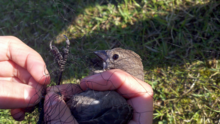
The eastern towhee is a large New World sparrow. The taxonomy of the towhees has been under debate in recent decades, and formerly this bird and the spotted towhee were considered a single species, the rufous-sided towhee.

Bird ringing (UK) or bird banding (US) is the attachment of a small, individually numbered metal or plastic tag to the leg or wing of a wild bird to enable individual identification. This helps in keeping track of the movements of the bird and its life history. It is common to take measurements and examine conditions of feather molt, subcutaneous fat, age indications and sex during capture for ringing. The subsequent recapture or recovery of the bird can provide information on migration, longevity, mortality, population, territoriality, feeding behavior, and other aspects that are studied by ornithologists. Other methods of marking birds may also be used to allow for field based identification that does not require capture.

A shark net is a submerged section of gillnets placed at beaches designed to intercept large marine animals including sharks, with the aim to reduce the likelihood of shark attacks on swimmers. Shark nets used are gillnets which is a wall of netting that hangs in the water and captures the marine animals by entanglement, however only around 10% of catch is the intended target shark species. The nets in Queensland, Australia, are typically 186m long, set at a depth of 6m, have a mesh size of 500mm and are designed to catch sharks longer than 2m in length. The nets in New South Wales, Australia, are typically 150m long, set on the sea floor, extending approximately 6m up the water column, are designed to catch sharks longer than 2m in length. Shark nets do not create an exclusion zone between sharks and humans, and are not to be confused with shark barriers.

Gillnetting is a fishing method that uses gillnets: vertical panels of netting that hang from a line with regularly spaced floaters that hold the line on the surface of the water. The floats are sometimes called "corks" and the line with corks is generally referred to as a "cork line." The line along the bottom of the panels is generally weighted. Traditionally this line has been weighted with lead and may be referred to as "lead line." A gillnet is normally set in a straight line. Gillnets can be characterized by mesh size, as well as colour and type of filament from which they are made. Fish may be caught by gillnets in three ways:
- Wedged – held by the mesh around the body.
- Gilled – held by mesh slipping behind the opercula.
- Tangled – held by teeth, spines, maxillaries, or other protrusions without the body penetrating the mesh.

Commercial fishing is the activity of catching fish and other seafood for commercial profit, mostly from wild fisheries. It provides a large quantity of food to many countries around the world, but those who practice it as an industry must often pursue fish far into the ocean under adverse conditions. Large-scale commercial fishing is called industrial fishing.
Mark and recapture is a method commonly used in ecology to estimate an animal population's size where it is impractical to count every individual. A portion of the population is captured, marked, and released. Later, another portion will be captured and the number of marked individuals within the sample is counted. Since the number of marked individuals within the second sample should be proportional to the number of marked individuals in the whole population, an estimate of the total population size can be obtained by dividing the number of marked individuals by the proportion of marked individuals in the second sample. Other names for this method, or closely related methods, include capture-recapture, capture-mark-recapture, mark-recapture, sight-resight, mark-release-recapture, multiple systems estimation, band recovery, the Petersen method, and the Lincoln method.

The Biological Dynamics of Forest Fragments Project is a large-scale ecological experiment looking at the effects of habitat fragmentation on tropical rainforest. The experiment which was established in 1979 is located near Manaus in the Brazilian Amazon rainforest. The project is jointly managed by the Amazon Biodiversity Center and the Brazilian Institute for Research in the Amazon (INPA).

Rocket nets and cannon nets are types of animal traps used to trap many live animals, usually birds, but they also have been used to catch large animals such as various species of deer. Rocket nets, cannon nets, and other net launching devices are built upon similar principles have been used since the 1950s.

Drift netting is a fishing technique where nets, called drift nets, hang vertically in the water column without being anchored to the bottom. The nets are kept vertical in the water by floats attached to a rope along the top of the net and weights attached to another rope along the bottom of the net. Drift nets generally rely on the entanglement properties of loosely affixed netting. Folds of loose netting, much like a window drapery, snag on a fish's tail and fins and wrap the fish up in loose netting as it struggles to escape. However, the nets can also function as gill nets if fish are captured when their gills get stuck in the net. The size of the mesh varies depending on the fish being targeted. These nets usually target schools of pelagic fish.

Bird control or bird abatement involves the methods to eliminate or deter pest birds from landing, roosting and nesting.
There are many field methods available for conducting avian ecological research. They can be divided into three types: counts, nest monitoring, and capturing and marking.

A net comprises threads or yarns knotted and twisted into a grid-like structure which blocks the passage of large items, while letting small items and fluids pass. It requires less material than something sheet-like, and provides a degree of transparency, as well as flexibility and lightness.

Bird netting or anti-bird netting is a form of bird pest control. It is a net used to prevent birds from reaching certain areas.

A hand net, also called a scoop net, is a handheld fishing net or meshed basket used to capture and retrieve objects from water, somewhat in the manner of a sieve. It is distinguished from other fishing nets in that the net or mesh is supported by a rigid circular or polygonal frame, which may or may not be mounted to the end of a handle.
This is a glossary of terms used in fisheries, fisheries management and fisheries science.
The Victorian Wader Study Group (VWSG) is an Australian non-profit, volunteer, ornithological fieldwork group that gathers biometric and other data on waders and terns, mainly through regular catches of large samples of several species by cannon-netting at sites along the coast of Victoria.

The following outline is provided as an overview of and topical guide to birds:

Bird trapping techniques to capture wild birds include a wide range of techniques that have their origins in the hunting of birds for food. While hunting for food does not require birds to be caught alive, some trapping techniques capture birds without harming them and are of use in ornithology research. Wild birds may also be trapped for their display in captivity in zoological gardens or for keeping as a pet. Bird trapping was formerly unregulated, but to protect bird populations most countries have specific laws and regulations.
The North American Bird Banding Program (NABBP), along with its Bird Banding Laboratory (BBL), has its home at the Patuxent Wildlife Research Center. The program is jointly administered by the Canadian Wildlife Service and the United States Geological Survey. The program is responsible for many aspects of bird banding in the United States and Canada: it grants permits to bird banders, fills orders for bands of various sizes, collects data from banding stations, receives reports from people who have found birds carrying bands, and makes its database available to appropriate parties.
The history of wildlife tracking technology involves the evolution of technologies that have been used to monitor, track, and locate many different types of wildlife. Many individuals have an interest in tracking wildlife, including biologists, scientific researchers, and conservationists. Biotelemetry is "the instrumental technique for gaining and transmitting information from a living organism and its environment to a remote observer".



















